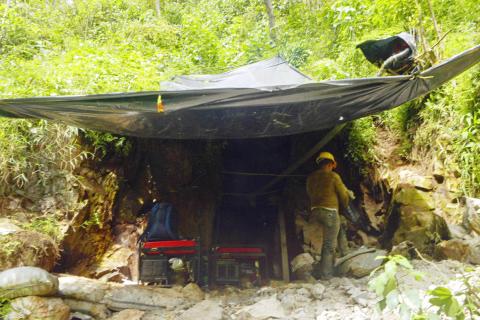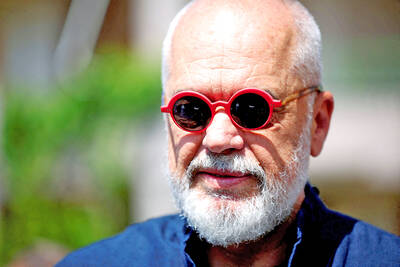Colombia’s widespread illegal mining is blamed for causing environmental damage and holding workers in slave-like conditions — and now is also being blamed for a malaria outbreak.
Critics point to stagnant water buildups at the clandestine sites and poor sanitary conditions at the workers’ camps for an increase in mosquitoes spreading the disease, which has quadrupled in jungle regions of the hard-hit and impoverished western department of Choco.
“The country had more or less controlled its malaria problem... The death rate had dropped significantly,” Colombian Minister of Health Alejandro Gaviria said this week. “But because of illegal mining ... we’ve had hotspots since last year and especially this year.”

Photo: AFP
Speaking on RCN radio, Gaviria said that malaria was especially on the rise in Choco — which stretches from the border with Panama along a stretch of Colombia’s Pacific coastline — as well as the Bajo Cauca area to the east.
The Colombian National Health Institute counted 18,524 malaria cases and about 300 cases of the disease’s more severe strain.
A year earlier, only 4,740 cases of malaria were recorded.
However, outbreaks of malaria due to clandestine mining are not new.
“Population displacement linked to the exploitation of gold mines [and resulting deforestation] has previously created isolated epidemics of malaria” in Latin America, the health institute said.
Mining is a major source of revenue for Colombia.
In 2012, the last year for which official figures are available, legal mining accounted for 2.3 percent of GDP, or US$8.5 billion.
However, authorities say that more than half of Colombia’s mining sites are illegal.
In these illegal mines, which help finance illegal armed groups, “excavators dig huge holes where water accumulates, perfect breeding grounds for malaria-carrying mosquitoes,” University of Antioquia researcher Ivan Dario Velez said.
And the sites where the miners set up camp “usually lack public utilities and have very poor hygiene conditions, which encourages the spread of mosquito and thus the disease,” he said.
Malaria symptoms include feverish headaches, chills, fatigue, nausea and vomiting.
Last year, about 214 million people suffered from malaria, of which 438,000 died from the disease, according to the WHO.
Most of those who died were children under five, the vast majority of them in Africa.
The malaria death rate has dropped 72 percent in South America since 2000, and the WHO expects to eradicate the disease in eight Latin American countries by 2020.
The outbreak in Choco is also linked to a shortage of medicine to fight the disease, the health minister said.
Gaviria said about 7,000 doses of needed medicine are being sent to the department, the poorest in the country.
From last year to this year, about 30 people died of malaria, most in isolated communities far from urban centers, according to the Office of the Ombudsman, which that warned this week of a “worrisome increase” in cases.
Separately, in February, officials launched an investigation into the deaths of 37 children and the poisoning of 64 others in the Choco region. The victims suffered from symptoms said to be linked to mercury, which is commonly used in illegal mining.

FRAUD ALLEGED: The leader of an opposition alliance made allegations of electoral irregularities and called for a protest in Tirana as European leaders are to meet Albanian Prime Minister Edi Rama’s Socialist Party scored a large victory in parliamentary elections, securing him his fourth term, official results showed late on Tuesday. The Socialist Party won 52.1 percent of the vote on Sunday compared with 34.2 percent for an alliance of opposition parties led by his main rival Sali Berisha, according to results released by the Albanian Central Election Commission. Diaspora votes have yet to be counted, but according to initial results, Rama was also leading there. According to projections, the Socialist Party could have more lawmakers than in 2021 elections. At the time, it won 74 seats in the

A Croatian town has come up with a novel solution to solve the issue of working parents when there are no public childcare spaces available: pay grandparents to do it. Samobor, near the capital, Zagreb, has become the first in the country to run a “Grandmother-Grandfather Service,” which pays 360 euros (US$400) a month per child. The scheme allows grandparents to top up their pension, but the authorities also hope it will boost family ties and tackle social isolation as the population ages. “The benefits are multiple,” Samobor Mayor Petra Skrobot told reporters. “Pensions are rather low and for parents it is sometimes

CONTROVERSY: During the performance of Israel’s entrant Yuval Raphael’s song ‘New Day Will Rise,’ loud whistles were heard and two people tried to get on stage Austria’s JJ yesterday won the Eurovision Song Contest, with his operatic song Wasted Love triumphing at the world’s biggest live music television event. After votes from national juries around Europe and viewers from across the continent and beyond, JJ gave Austria its first victory since bearded drag performer Conchita Wurst’s 2014 triumph. After the nail-biting drama as the votes were revealed running into yesterday morning, Austria finished with 436 points, ahead of Israel — whose participation drew protests — on 357 and Estonia on 356. “Thank you to you, Europe, for making my dreams come true,” 24-year-old countertenor JJ, whose

BACKLASH: The National Party quit its decades-long partnership with the Liberal Party after their election loss to center-left Labor, which won a historic third term Australia’s National Party has split from its conservative coalition partner of more than 60 years, the Liberal Party, citing policy differences over renewable energy and after a resounding loss at a national election this month. “Its time to have a break,” Nationals leader David Littleproud told reporters yesterday. The split shows the pressure on Australia’s conservative parties after Prime Minister Anthony Albanese’s center-left Labor party won a historic second term in the May 3 election, powered by a voter backlash against US President Donald Trump’s policies. Under the long-standing partnership in state and federal politics, the Liberal and National coalition had shared power